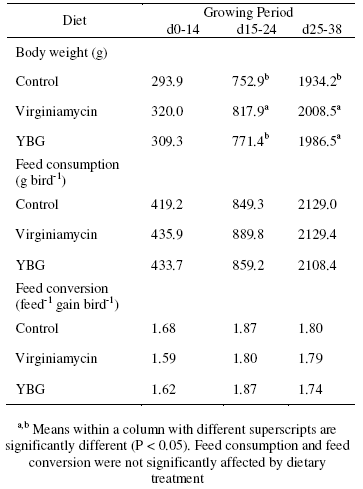



Yeast Beta Glucans and Broiler Chicken Growth
From the Atlantic Poultry Research Institute by B. Rathgeber, Agricultural and Agri-Food Canada, Kentville, NS, K. Budgell, Nova Scotia Agricultural College, Truro, NS, J. MacIsaac, Atlantic Poultry Research Institute, Truro, NS M.Mirza, Institute of Animal Nutrition and Feed Technology, University of Agriculture, Pakistan. Antibiotics are commonly incorporated in the diets of broiler chickens at low (subtherapeutic) levels to improve growth and feed efficiency, to decrease flock variability, to prevent disease and to improve digestion of carbohydrates and fats.Introduction
Antibiotics are commonly incorporated in the diets of broiler chickens at low (subtherapeutic) levels to improve growth and feed efficiency, to decrease flock variability, to prevent disease and to improve digestion of carbohydrates and fats. Their use has facilitated the efficient production of reasonably priced, high quality meat and has enhanced the wellbeing of poultry by reducing incidence of disease. In recent years, there has been an increase in bacterial resistance to antibiotics in both human and animal populations, as well as an increasing consumer concern for animal drug residues in meat. As of January 1, 2006 the European Union imposed a complete ban on the use of antibiotics in animal feed as growth promotants. As these bans are being considered in other countries, non-antibiotic alternatives with the same efficacy must be evaluated. Numerous antibiotic alternatives are in use or have been proposed as a means to eliminate pathogens or to improve growth and feed conversion, including probiotics, enzymes, bacteriocins, antimicrobial peptides and bacteriophages. Glucans derived from yeast cell wall are promising alternatives to antibiotics, as they have been shown to improve growth performance and stimulate the immune system of immature broilers. The objective of this study was to determine the efficacy of a yeast beta-glucan product (YBG) as an alternative to virginiamycin in market age broiler chickens.
Trial
In each of three trials, 912 day old boiler chicks were randomly allocated to 24 pens, with 38 birds per pen (0.073 m2 per bird). Birds were fed one of three dietary treatments: 1) standard diet without antibiotic; 2) standard diet + virginiamycin; or 3) standard diet + YBG. YBG was included at 40 g per tonne in the starter diet and 20 g per tonne in the grower and finisher diets. Body weight and feed intake were recorded on days 0, 14, 24, and 38.
Results
Results were consistent among the three trials, therefore information presented below represent pooled data from all three trials. Body weight did not differ among dietary treatments early in the trial (day 14). At day 24, birds receiving the antibiotic diet were significantly larger than those receiving the control or YBG diets. By day 38, birds receiving YBG and virginiamycin diets were similar in size, and were significantly larger than birds offered the control diet. Feed consumption and feed conversion were not affected by diet or sex of the birds.
Table 1. Body weight, feed consumption and feed conversion of broiler chickens fed yeast beta glucan (YBG), virginiamycin or a control diet for 38 days.

Industry Impact
Body weight and feed conversion were not affected during the starter period, suggesting that YBG did not play an active role in growth performance during the initial stage of development. However, birds receiving YBG were similar in size to those receiving virginiamycin by day 38, demonstrating that the positive effects of beta-glucans on growth performance are delayed until the latter stages of development. Weight gain and feed consumption were similar for birds fed YBG or antibiotic diets, indicating that YBG may effectively replace virginiamycin as a growth promotant for male or female broilers grown to 38 days of age. Further research is recommended to optimize inclusion rates of yeast beta-glucan in broiler diets to maximize growth promotion, and to determine their effects on the microbiological profiles of broiler digestive tracts.
December 2007











